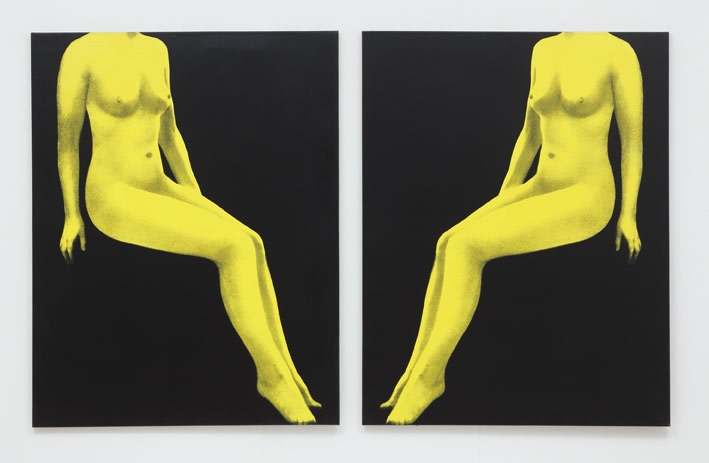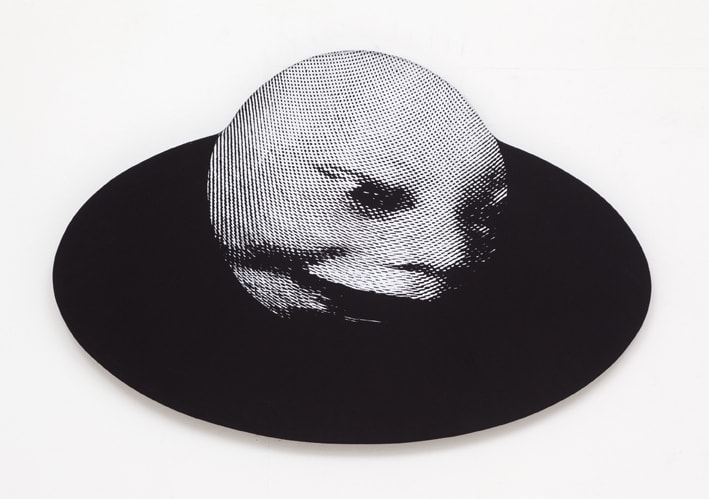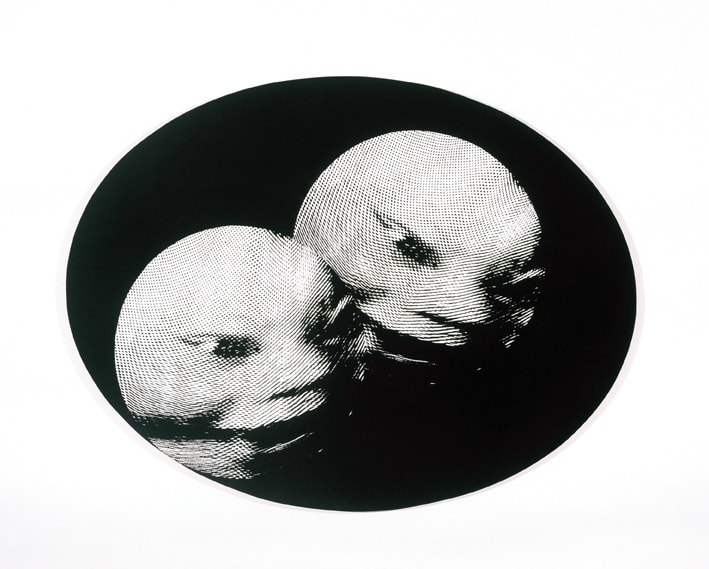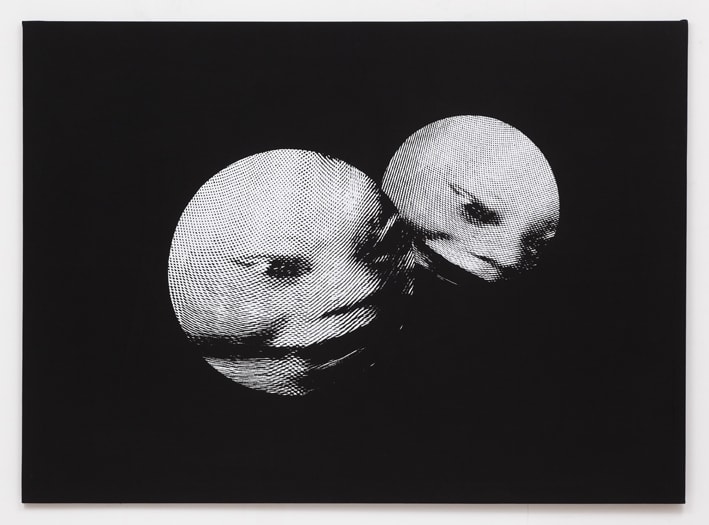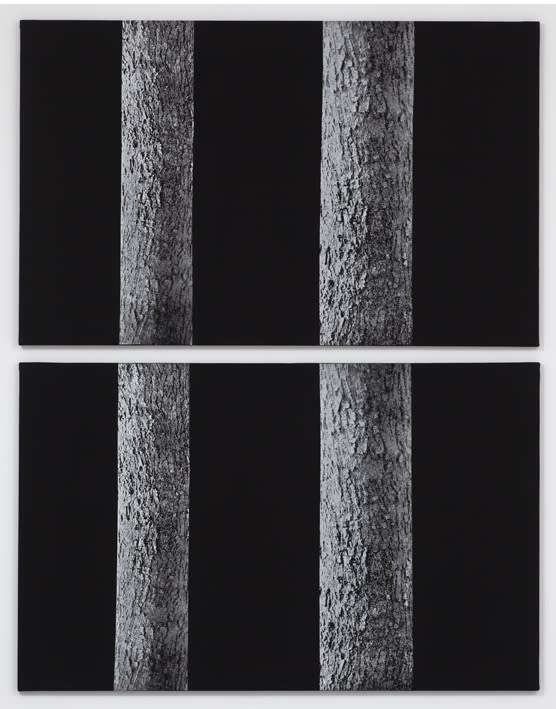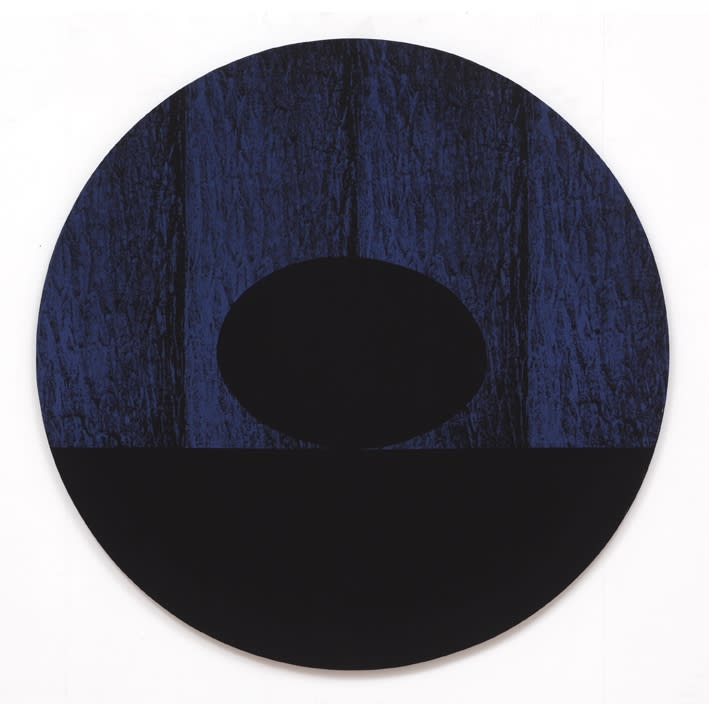John Stezaker
Neither culture nor its destruction is erotic. It is the seam between them, the fault, the flaw, which becomes so.
Roland Barthes
John Stezaker is an artist for whom working in series has always come naturally. The best of these, such as ´The Film Portraits´, ´The Film Stills´and ´The Masks´, are the result of several decades spent working through the formal possibilities and semantic implications involved in applying a specific, limited set of transformative procedures to a generic and comparably delimited corpus of found imagery. All of the series just mentioned are small-scale collages, the medium with which Stezaker has to date been most intimately associated. It is significant that the labels provided for these series derive from their pictorial content rather than the mechanics of their facture. In contrast, the works referred to collectively as ´The Screenprints´appear not to constitute a series per se, but rather a heterogeneous succession of overlapping series, executed in the same medium between 1977 and 1994. While the medium in question, mid- to large-scale silkscreen printing on fabric, is one which even then was obsolescent and today is mostly confined to certain backwaters of the clothing industry, it was also a favoured medium of the artist who supplied these works with their most formidable precedent, Andy Warhol. The decision to reconfigure in 2010 a body of work completed, one might even say abandoned, more than 15 years ago, which is arguably the most disjointed in Stezaker´s multifarious oeuvre, necessarily entailed processes of re-viewing and re-membering on the artist´s part. To consider them collectively requires a corresponding effort on the part of the contemporary viewer to whom these works are newly addressed. This is in spite of the fact that most of them have never before been exhibited. Any attempt to perceive the screenprints in retrospect as constituting a cohesive whole is daunting, if not doomed to failure. The best to be hoped for eventually is to trace in the emergence, proliferation, abstraction and ultimate evacuation of various motifs – at different stages during this period, and subject to different rhythms of elaboration – certain points of concentration and condensation that might shed light on the artist´s abiding concerns. In any case, the most salient aspect of Stezaker´s oeuvre from the outset is that it is both constituted by fragments and riven by seams. In this he is neither alone nor unprecedent. As Kaja Silverman has recently reminded us, the repetition and explotation of fragments, their constant metamorphosis and renewal in context and meaning, was a characteristic strategy of modernism´s early masters (she cites Rilke, Nietzsche, Rodin, Cézanne, Proust and Valéry in this regard). Given that her point is made in a discussion of the gradual emergence of the ´a-relational male subject´that typified modernism, it seems appropriate to re-examine Stezaker´s screenprints, produced against the backdrop of heated debates around postmodernism, from this perspective. What to make, then – or, rather, now – of the solitary male figures and kissing couples, disintegrating or isolated against black voids; the blurred processions and marmoreal tableaux of nude female torsos; the kaleidoscopic choreographies of topless models and disembodied professional men; the breached domesticity of the sundered family; and, of course, the floating baby-heads, the most disconcenrting of this menage(rie) of motifs, even when their faces are not anamorphically stretched into a ghoulish grimace? The vectors of identification and estrangement seem impossibly dizzying. How, then, to construe the subsequent transmutation of these looming heads into eerily illuminated globes that bob through dark voids bounded by trompe l´oeil, tree bole ´frames´, or roam through Piranesian stairwells that resemble a film set for the 1960s cult TV series The Prisoner designed by a disciple of Odilon Redon? Here, the abstracted intimations of aimlessness and entrapment are no less confounding. Where, finally to start, in the foreknowledge that we will end up faced with the skewed image of a blank white screen excised from the black ground that frames it, or this image´s reverse? Like quite a few of the forms and motifs that recur in the screenprints, these vacant rhomboids – euqally reminiscent of a blank page, canvas or film screen – originate in the smaller photo-collages, in particular in a series of works presented under the rubric ´Tabula Rasa´. The shift in scale, medium and format, however, crucially inflects their meaning. For a start, it amplifies that concern with spatial perception already evident in the collages so as to accomodate an awareness of the embodied viewer´s physical interaction with wall-hung pictures which are, in some cases, more than four metres long. The persistent combination of photographically derived images, including those related to the film industry, with eccentrically shaped and configured canvas stretchers, suggests an ambitious if uneasy suturing of photography, cinema and painting (most obviously in echoes of the late modernist abstraction of Newman, Stella and Noland). Comparable exercises in hybridization can be traced in work from the early 1980s by Stezaker´s American contemporaries of the ´The Picture Generation´, such as Jack Goldstein, Troy Brauntuch, Richard Prince and Robert Longo, who were also labouring in Warhol´s wake. That said, a distinguishing feature of Stezaker´s work is the historical depth and recondite span of its range of reference, resulting in a headier mix of fine art and popular culture, of high seriousness and low comedy, than that of his peers. Who else would produce works such as the kaleidoscopically rotated, four-panel Sky, 1982 or Untitled, 1988 somehow simultaneously evoking a Venetian ceiling by Tintoretto and an Esther Williams synchronised swimming routine. As Stezaker himself recalls the limited and largely private reception of his screenprints during the 1980s, the baby-heads were the most persistently discomfiting, but the female torsos proved to be more immediately contentious. This is hardly surprising, coming at the close of a decade marked by an intense critique of representation informed by Marxist theory, psychoanalysis and feminism, whose classic formulation remains Laura Mulvey´s 1975 essay on the subjugating violence of the male gaze. Stezaker remembers being taken aback by the vehemence of the negative response from a position with which he had previously felt aligned. Yet it seems increasingly evident that his work has had little to do with the demystification of the image and the exposure of its ideological underpinnings. The form of attention he brings to bear on the image has generally been more exploratory than analytical, more submissive and productive than subversive or critical; his interventions and manipulations consequently tending more towards delirium than critique. Repetition, for Stezaker, is a form of intensification rather than distantiation (Warhol) or deconstruction (´The Pictures´artists), as are the ancillary processes of dissolution, fragmentation, displacement, overlaying, mirroring, permutation, rotation and disorientation. (The use of colour saturation has a similar effect of intensification.) These formal strategies conspire to make strange – or, better, to make stranger – images chosen from a perversely heterogeneous and idiosyncratic image-hoard marked by a preference for the arcane rather than the truly popular. Barbara Kruger´s description of the type of picture that attracted the appropriative attentions of her contemporaries, ´the value of which might already be safely ensconced within the proven marketability of media imagery´, seems categorically inappropriate to Stezaker, for whom images in mass-circulation hold little interest. His male figures gleaned from obscure photo-romans, the female nudes excised from mid-century naturist magazines or art technique manuals, the babies found among the pages of women´s knitting magazines, are of a different order than that of the Warholian celebrity or socialite, or the Madison Avenue advertising machine. Among the ´problematic´images of headless female torsos, Veil, 1980-83, though arguably an atypical work in that it is not on stretched canvas, is particularly intriguing, even emblematic. This is a diaphanous frieze, roughly one metre by three metres, composed of the horizontally repeated and overlapping black-and-white pthotographic image of a nude female torso imprinted on two layers of fabric, one of muslin and one of organza. The violence visited upon the source image, the decapitation of the female figure, cannot be disavowed. Neither can the pulsations of desire and dread set in train by its serial repetition, nor the dynamic of exposure and concealment excited by the layered fabric. The viewer´s response to this (or to any other) image will of course be inflected by the myriad factors that constitute a given subject position, including gender and sexuality. Yet the underlying (though not overriding) condition of that response must be the confrontation with an image-object that both invites and rebuffs exacting scrutiny, from whatever vantage point, physical or ideological. The palpable urge to lift one of the veils, for instance, is surely universal. What Veil proffers is, in essence, a picture of protracted trepidation. Is it too much to suggest that this trembling of the veil also reflects an oscillation between a desire to see and a need to know? After all, as engaged viewers, thwarted in our attempt really to see this image, we may fall to reflecting on what we can come to know about it. The art-historical resonances alone, which Veil conjures are considerable, from classical friezes such as the Elgin Marbles or the Assyrian wall-relief, currently in the British Museum, through Eadward Muybridge´s early photographic investigations of human locomotion, to Marcel Duchamp´s Nude Descending a Staircase, 1912 as well as the headless female figure in Ètant Données, 1946-1966. But does a consideration of these relatively remote antecedents bring us any closer to an understanding of this art work? Georges Didi-Huberman, in his radically revisionist history of art, offers a potentially productive account of this impasse. Whereas the self-consciously sophisticated art historian (´he who chooses only to know´) may gain the unity of synthesis and self-evident reason, this may well be at the expense of losing ´the real of the object´. Conversely, the naive beholder (´he who desires to see, or rather to look´) may lose ´the unity of an enclosed world´only to find himself in the uncomfortable opening of a universe henceforth suspended, subject to all the winds of meaning´. For Didi-Huberman, the way forward is in fact a return: a return, that is, to ´a questioning of the image that does not yet presuppose the „figured figure“´, i.e. the figure fixed as representational object, but rather what he terms the ´figuring figure, namely the process, the path, the question in action, made colours, made volume…´. It is important to note that this dynamic form of attention, open to intensities, does not entail a rejection of logic or a recourse to the poetics of unreason. Instead it calls for an aknowledgment of the play of logic within ´the world of images´, a domain that is not without structure, but whose structure is ´rent, breached, riuned at its centre as at the crucial point of its unfolding´. This approach may offer some solace to the viewer faced with the more rebarbative of Stezaker´s screenprints. It is also of some assistance to the critic charged with providing a preliminary description of the screenprints in toto. The significance of frames, edges and seams is emphasised throughout this body of work. Yet these threshols and boundaries are porous and constantly breached. They can neither contain the figures within them nor prevent the transmigration of mutating forms across them. A comprehensive account of the ravelling thread of motifs that unwinds through this disseminated field lies beyond the scope of this short essay. However, the penultimate series of screenprints, all from 1989, as they are now presented to us, may prove to be particularly pertinent. Stezaker refers to this as ´The Observatory´series, though the actual setting for these images is the Church of St. Nicholas in Prague. Given this information, the intimations of Kafka´s Castle, and the suggestion of panoptic incarceration, are difficult to ignore. The gleaming orbs that feature so prominently in these pictures, which evolved, or devolved from the floating and distended heads, can also be related to the image of the egg, the eye, and even the trompe l´oeil car-tyre. (This decidedly Bataillean chain of visual associations speaks to Stezaker´s complex debt to surrealism). They may be likened to celestial bodies or microbic particles, free only to wander through the vertiginous architecture in which they are trapped. More than any other series, ´The Observatory´screenprints suggest that in order to fathom the true significance of Stezaker´s often inscrutable imagery we must find some way out of what Didi-Huberman, following Kant, describes as that strange, opaque, extendable net ´whose every mesh is made only of mirrors´, an enclosure that is ´speculative and specular at the same time´, and which he calls the ´box of representation´.
We must try to break through this reflecting zone where speculative and specular compete to invent the object of knowledge as a simple image of the discourse that pronounces it and judges.
As Didi-Huberman concedes, even a partial breaching of these boundaries runs the risk of death for the subject of knowledge, which is to say the risk of non-knowledge. But, then again, ´this risk will be suicidal only to him for whom knowledge is the whole of life´. The screenprints of John Stezaker rank high on the list of contemporary art works that make that risk worthwhile.
Caoimhín Mac Giolla Léith, July 2010
-
 John StezakerUntitled, 1980Silkscreen on canvas101 x 450 cm / 40 x 177.16 inches
John StezakerUntitled, 1980Silkscreen on canvas101 x 450 cm / 40 x 177.16 inches -
 John StezakerUntitled, 1980Silkscreen on canvas100 x 300 cm / 39.37 x 118.11 inches
John StezakerUntitled, 1980Silkscreen on canvas100 x 300 cm / 39.37 x 118.11 inches -
 John StezakerCatcher, 1982Silkscreen on pinstriped fabric88.5 x 228.5 cm / 34.84 x 90 inches (each)
John StezakerCatcher, 1982Silkscreen on pinstriped fabric88.5 x 228.5 cm / 34.84 x 90 inches (each)
228.5 x 228.5 cm / 90 x 90 inches (installed) -

-
 John StezakerUntitled, 1982Silkscreen on canvas120 x 100 cm / 47.24 x 39.37 inches (image)
John StezakerUntitled, 1982Silkscreen on canvas120 x 100 cm / 47.24 x 39.37 inches (image)
220 x 220 cm / 86.61 x 86.61 inches (installed) -
 John StezakerUntitled, 1983Silkscreen on canvas100 x 203 cm / 39.37 x 79.92 inches
John StezakerUntitled, 1983Silkscreen on canvas100 x 203 cm / 39.37 x 79.92 inches -
 John StezakerUntitled (from the Series The Egg Burial), 1985Silkscreen on canvas66.7 x 101.5 cm / 26.25 x 39.96 inches
John StezakerUntitled (from the Series The Egg Burial), 1985Silkscreen on canvas66.7 x 101.5 cm / 26.25 x 39.96 inches -
 John StezakerUntitled (from the Series The Egg Burial), 1985Silkscreen on canvas73.5 x 91 cm / 28.93 x 35.81 inches (part 1)
John StezakerUntitled (from the Series The Egg Burial), 1985Silkscreen on canvas73.5 x 91 cm / 28.93 x 35.81 inches (part 1)
29 x 91 cm / 11.41 x 35.81 inches (part 2) -
 John StezakerUntitled (from the Series The Egg Burial), 1985Silkscreen on canvas91 x 138 cm / 35.82 x 54.33 inches
John StezakerUntitled (from the Series The Egg Burial), 1985Silkscreen on canvas91 x 138 cm / 35.82 x 54.33 inches -
 John StezakerUntitled (from the Series The Egg Burial), 1985Silkscreen on canvas143.8 cm / 56.61 inches (diameter)
John StezakerUntitled (from the Series The Egg Burial), 1985Silkscreen on canvas143.8 cm / 56.61 inches (diameter) -
 John StezakerThe Egg Burial, 1985Silkscreen on canvas120 x 156.5 cm / 47.24 x 61.61 inches
John StezakerThe Egg Burial, 1985Silkscreen on canvas120 x 156.5 cm / 47.24 x 61.61 inches -
 John StezakerConjunction (from the Series The Egg Burial), 1985Silkscreen on canvas134.5 x 185 cm / 53 x 72.83 inches
John StezakerConjunction (from the Series The Egg Burial), 1985Silkscreen on canvas134.5 x 185 cm / 53 x 72.83 inches -
 John StezakerUntitled, 1986Silkscreen on canvas91 x 145.5 cm / 35.82 35 x 57 inches (each panel)
John StezakerUntitled, 1986Silkscreen on canvas91 x 145.5 cm / 35.82 35 x 57 inches (each panel)
182 x 145.5 cm / 71.65 x 57.28 inches (installed) -
 John StezakerUntitled, 1987Silkscreen on canvas166 x 87 cm / 65.35 x 34.25 inches
John StezakerUntitled, 1987Silkscreen on canvas166 x 87 cm / 65.35 x 34.25 inches -
 John StezakerNight-Watch, 1988Silkscreen on canvas143 x 221 cm / 56.29 x 87 inches
John StezakerNight-Watch, 1988Silkscreen on canvas143 x 221 cm / 56.29 x 87 inches -
 John StezakerFloor, 1988Silkscreen on canvas305 x 308 cm / 120 x 121.25 inches (installed)
John StezakerFloor, 1988Silkscreen on canvas305 x 308 cm / 120 x 121.25 inches (installed) -
 John StezakerUntitled, 1989Silkscreen on canvas132 cm / 52 inches (diameter)
John StezakerUntitled, 1989Silkscreen on canvas132 cm / 52 inches (diameter) -
 John StezakerUntitled, 1989Silkscreen on canvas229 cm / 90 inches (diameter)
John StezakerUntitled, 1989Silkscreen on canvas229 cm / 90 inches (diameter) -
 John StezakerUntitled, 1989Silkscreen on canvas213.5 cm / 84 inches (diameter)
John StezakerUntitled, 1989Silkscreen on canvas213.5 cm / 84 inches (diameter)



